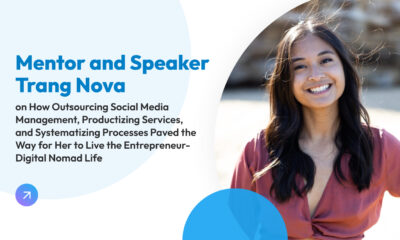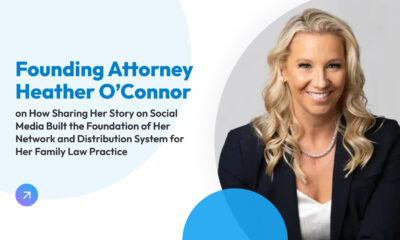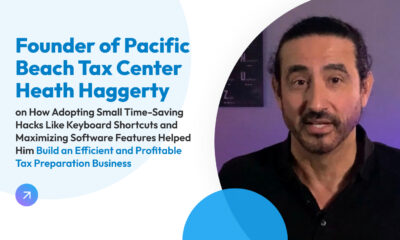Case Study
Real Estate Agent Denise Schroder On Selling 10 Times More Than Her Competitors and Even Landing a TV Show
Real Estate is often considered a commoditized and saturated industry so when Denise Schroder decided that she wanted to get her real estate license and open a business, she was met with skepticism from those in her circle at the time, especially since she and her husband already had teenagers…yes, teenagers! Schroder and her husband, Troy were far from being college kids who could live on ramen noodles to bootstrap their company. In this article, Schroder walks us through the challenges she and her husband faced chasing their dream and the people, systems and tools that were truly key to her success. Don’t forget to check out Schroder’s Productivity Stack Quick Reference and her Read-Watch-Listen List!
Table of Contents
Starting
Challenge 1: How to overcome limiting beliefs & naysayers
When Schroder started out, she remembers being surrounded by limiting beliefs. “I was told over 20 years ago when I wanted to get my real estate license, that I could never make it. I wasn’t good enough. I could never stand out in such a saturated industry.” And like many entrepreneurs, Schroder let it get to her, at first. “I felt like I needed permission to pursue taking a leap of faith, and I didn’t have that,” she explains.
Solution: Schroder and her husband Troy Schroder ultimately decided the dream was more important than the fear and quit their jobs on the same day, putting both their backs against the wall. Failure was not an option. But what made her overcome the naysayers and fear? Schroder explains what tipped the scales. Her mother passed away due to being misdiagnosed and it really changed things for her: “I had such a paradigm shift when she died that I just truly live like there’s no tomorrow.”
People: Schroder and her husband Troy
Systems: Performance Pressure: defined as applying pressure to optimize performance. If you’re someone who often says you “work well under pressure,” you might be using this system. A variety of studies have been done looking at the effect of performance pressure on anything from public employees to employees’ in-role behaviors but the relevant takeaway from the studies is that it’s important to use this system carefully as too much pressure can backfire and produce anxiety and degrade performance but likewise, too little pressure can lead to lack of motivation or interest.
Tools: Resignation letters!
Challenge 2: Bootstrapped budget and a short runway for the business to succeed
Upon turning in their simultaneous resignations, the Schroders had $30,000 in the bank, which might not sound too bad until you consider that they had a total of seven mouths to feed. “We had five teenagers and that meant driving, braces, incidentals, all the things!” On top of that, these weren’t little kids, so they were fully aware that their parents had just left their jobs along with their comfort of stability and they were “somewhat terrified,” Shcroder tells us.
Solution: Seven months of patience, hard work, and belief that her input would pay off. Denise Schroder is a farmer’s daughter from Oklahoma and one thing she learned from her father and put into practice in her real estate business is the importance of planting seeds. “My dad kept telling me, Denise, you’ve seen your entire life what I do. We plant seeds, we water, we spray, we plow, we disc before the harvest. It takes a lot of time. And so he said, keep doing what you’re doing consistently and the harvest will come. And he was one of our biggest supporters.” And wow did her seed-planting pay off in her real estate harvest! She spent seven months planting seeds and being patient and then the harvest came. “In the last five months of the year, we sold 40 homes all at once,” she remembers. In case you’re wondering what those seeds were, “doing things differently with a social media presence,” Schroder explains. Don’t worry, we’re about to dig deeper into her social media strategies so read on!
People: Denise & Troy Schroder.
Systems: A clear focus on planting seeds through social media that she knew would not reap rewards immediately. Patience & consistency were also huge factors here. Despite the lack of results for so long, she trusted that it was worth the hard work and continued past the point where others might have assumed the strategy had failed.
Tools: Instagram, Facebook, TikTok
Challenge 3: Distribution. How to get (a lot of) clients in a “saturated” or “commoditized,” industry
While patience and seed planting make sense in general, we wanted to know why her social media worked so much better than the next REALTOR®. Forty homes means that she sold roughly 10 times what her competitors did in the same time frame. “The average agent sells four to eight a year,” explains Schroder. That’s quite a huge difference.
Solution: “I did Oprah Winfrey in 1999. I knew the power of storytelling and being vulnerable,” she tells us.
Sidenote: Before you start thinking this means that her methods won’t work unless you, too, are interviewed by Winfrey (hey, we hope you are, but just in case you aren’t), definitely keep reading because this is where Schroder breaks down her method and how it’s what landed her the Oprah show in the first place.
So how did she end up on the Oprah show? She explains she was a stay at home who was really struggling with her health and doctors were not listening to her, so she wrote a “Hail Mary” letter about what she was going through, out of pure frustration and sent it to the show. “I did an emotional dump. I never expected to hear back from her, but I felt better after I wrote the letter. I was trying to advocate for myself and my body, but I couldn’t get anyone to listen to me. And I got a call back in an hour.”
This was such a powerful story and a reminder that while Oprah is a big star with a huge team, she’s also a person and her team is made up of people. This is similar to the story of another entrepreneur we interviewed here who took his shot by simply reaching out directly to Google, which, while it’s a behemoth company, is still made up of people. Remembering this can really pay off, just like it did here for Schroder!
Beyond the obvious payoff of hearing back, it showed her how strong the power of storytelling really was. “I knew that I could use this in any business, just storytelling. I’m a REALTOR® and selling houses is a byproduct of what we do. At the end of the day, I’m a storyteller.” Schroder goes on to explain more about how this applies to social media in particular. “I tell my story. But I also want to tell my clients’ stories because they have such beautiful ones, and that’s what stops the scroll is telling stories and being creative in the way we do that.” She mentions she has used this same system and applied it to everything from podcast guesting, to press releases, human interest stories, volunteer teaching, and speaking. In terms of what she actually posts, she says “80% is life with us and 20% is real estate.”
People: Denise & Troy Schroder.
Systems: Storytelling (not selling) as the primary focus across social media, speaking engagements, and more.
Tools: Instagram, Facebook, TikTok, Canva
Growing
Challenge 4: How to grow a network exponentially instead of person-by-person
One really interesting thing Schroder talked about during her interview was that because she was on the Oprah show, she was subsequently asked to appear on a follow-up show for Oprah, and then the Steve Harvy show on topics ranging from hormone imbalance to dangerous apps kids are using and how to blend a family. On the surface, it might have made more sense for her to turn down these requests because they didn’t have anything to do with real estate but she accepted even though there was no clear direct way to leverage this for her business.
Solution: Because Schroder was laser-focused on storytelling (as opposed to real estate), while these stories didn’t necessarily come with a built-in way to boost her bottom line, it did do something else that was powerful. She got in front of significantly more people when she was on Oprah or Steve Harvy than she would have through simply building her social media presence bit by bit.
Schroder goes on to explain how she’s managed to tie being a REALTOR® to these seemingly completely unrelated topics. “When we’re in the media, it’s always ‘Denise Schroeder, Oklahoma City REALTOR® is on Steve Harvey, on HGTV, etc.’” In fact, she says “when Steve introduced us, he introduced us as the blended family experts that quit our job on the same day to do real estate. So we’ve been able to tie what we do to many different topics and make a difference in ways other than just talking about selling houses.”
People: Public figures with large audiences.
Systems: Networking with individuals who have a much larger reach than the Schroders did on their own. And once again, storytelling, even if it wasn’t specifically real estate-focused.
Tools: None.
Challenge 5: How to do 10x the work of your competitors, in the first year
Now, of course, it sounds amazing to get flooded with clients all at once while hitting your first year in business, but that means they were hit with a lot of clients to serve and a lot of work to do all at once, too. There was a lot to do to execute these deals smoothly. So how did they make sure everything didn’t come crashing down?
Solution: “We had all the software and a CRM [Customer Relationship Management tool] in place, or I think we would have been set up for failure,” Schroder emphasizes. She already had proper processes, checklists, and systems in place prior to this huge influx of clients. “Otherwise too many things fall through the cracks and we disappoint people and we don’t get referrals…we don’t get repeat business and that was just not an option for us.” She describes the CRM she was using, Brivity as her key for communicating with her clients automatically so clients aren’t left wondering what she’s doing to sell their home. “Every time I complete a task, you’re going to get either a daily or weekly reminder, whatever, you set it up.” This means clients also didn’t need to be following up with her to ask lots of questions, allowing her to focus on selling their home. For regular communication with clients and prospects outside of active listings, she also mentions that she uses Mailchimp to send out regular newsletters.
It’s not too often that you come across an entrepreneur who sets up their systems this far in advance of when those systems are actually needed so we had to ask, how did Schroder even know she needed these systems or to set them up so they wouldn’t break under such high pressure? Answer: Keller Williams training & systems setup. “I knew that [Keller Williams] had spent the most money and invested in technology, and that’s why we went with them, because I knew that I wanted to be the most educated and competent real estate agent that I could be.” Schroder credits Keller Williams with helping her not just in setting up a single piece of software, but also teaching her business planning, time blocking, and more. She says she’s still going to classes today and seeking out her own education to keep improving. “I don’t want to ever stop being a student,” she confirms.
People: Schroder and her husband, Troy.
Systems: Setting up an all-inclusive CRM that handled client communication in an automated way prior to having a lot of clients. This step would later prove crucial for hiring a team.
Challenge 6: How to hire when your customers want YOU
At this point, things were humming along nicely. Clients were rolling in, Schroder’s systems were solid and operating properly, but she knew she wanted to keep growing, so it was time to hire, but this caused new issues. Clients expected Schroder or her husband to be the one to show their houses and be physically present. This is unsurprising and fairly common since these clients trusted Schroder and her husband and that’s who they wanted to work with. This issue is very similar to one that another entrepreneur we interviewed faced when growing his sales team.
Solution: Schroder hired a transaction coordinator and a buyer’s agent and then implemented scripts she’d use with her clients to prepare them during client onboarding “where they understand they’re going to be cared for and you’re going to be overseeing things, but sometimes they’ll interface with another person in your absence” she explains. She interacted and managed both the new hires and the clients through Brivity, which she says is a CRM but also has the functionality of Slack and Todoist built in, though in a nod to Todoist, she says she still uses Todoist quite frequently to manage her own time.
People: Transaction Coordinator and Buyer’s Agent
Systems: Scripts to help the clients understand that while Schroder would be present and overseeing things, the client would sometimes interact with someone else on the team.
Tools: Brivity, Todoist, Slack
Challenge 7: How to hire the right people & for which roles
Schroder explains that she relies heavily on her team and systems so that team needs to be reliable and top quality. “We’re very selective,” she states outright. She emphasizes that another reason she feels that “no room for failure” pressure is that she waited so long to pursue her dream and her team is part of that. We also asked her to detail which roles she’s filled and duties she’s offloaded and she admits that several roles were ones she truly enjoyed and didn’t want to give up. This is in contrast to another hiring strategy, namely that of hiring for the roles the entrepreneur simply doesn’t enjoy or isn’t highly skilled at.
Solution: Schroder has a stringent screening process and is willing to accept when people simply are not a fit. “We’ve had some hires we’ve had to let go because we have very high expectations.” She has used her screening process for hiring virtual assistants for a variety of jobs including Canva or postcard design, a transaction coordinator, and a buyer’s agent. Graphic design has been one of the most difficult things for Schroder to offload because of how much she enjoys it. “It energizes me. But at some point you have to prioritize how much time you have in a day so I really had to learn to just let that go so I can do things that are income generating or make more sense.” As an example, she says having coffee or lunch with clients is a better use of her time than designing a postcard. For managing hiring and interfacing with her team, she uses a combination of Brivity, Slack, and Todoist.
People: virtual assistants for a variety of jobs including Canva or postcard design, transaction coordinator, and buyer’s agent
Systems: Stringent screening process to ensure the highest chance of success with the hires. Willingness to let people go when they’re not the right fit.
Tools: Brevity, Slack, Todoist, Canva
Scaling & Success
Challenge 8: How to optimize time management in the face of “fires” or urgent problems
Schroder shared some serious tough love with us too when she started talking about something we as entrepreneurs are all too familiar with – that nagging urge to “put out fires.” “The truth is, I can’t divert [from my schedule] to go put out a fire, because I could find a fire every five minutes.” She even goes on to really share why she has struggled with this herself and why many of us likely do as well – because we care! “When you care about people, fires seem to escalate a little bit higher.”
Solution: Time blocking. Schroder explains that she time blocks for lead generation as well as other items like writing. “Everything is silenced,” she says. And this isn’t something that comes naturally to her either “I’m a get-it-done person,” she explains. As soon as something pops up, she’d truthfully rather just be reactive, handle it immediately and get it checked off but she’s had to learn that the reality is, if that thing can wait 3 hours, it’s more efficient to be strategic and continue with the scheduled time block and then handle the item that popped up later, perhaps in its own time block instead.
A turning point in time blocking came when she was preparing to write her book, Out of the Box: My Response to Everyone Who Said I Could Never Sell Real Estate, because she explains “I really needed to have white space to write and just sit in my own thoughts” and she found some assistance with committing to time blocking through the book Getting Things Done by David Allen. This book taught her about buckets for “doing it, delegating it, deferring it, and dropping it” and she describes it as “pivotal” and the true moment she committed to time blocking. One of the book’s lessons that really resonated with her was that “there is no such thing as multitasking,” she remembers.
People: No additional people.
Systems: Time blocking.
Tools: Getting Things Done, Google Calendar.
Challenge 9: How to implement time blocking when you’re in a responsive industry
“If I don’t answer my phone, I don’t get business,” Schroder states outright. So, we wondered, how does that work with time blocking? Does she interrupt her blocks to answer her phone? If not, is the phone going to voicemail?
Solution: Schroder explains that she has two primary blocks that require a silenced phone and laser focus (lead generation and writing). In order to keep those time blocks notification-free, she has her business set up with a Google Voice number, which means that multiple phones can answer the same phone number. So when she’s writing, her husband or another team member answers the phone, maintaining that responsiveness. An added benefit for her team is that regardless of who is calling a given client, the client is receiving the call from the same phone number creating an additional level of continuity for her business.
People: Everyone on her team
Systems: time blocking, shared responsibility of answering incoming calls by the team
Tools: Google Voice
Challenge 10: How to find success in the face of covid & a downturned market
“We had 1,900 homes on the market in Oklahoma City during COVID and we normally have 7,500, so it was cut throat,” Shcroder recalls. That means their business was down a whopping 75%. Schroder explains that in this market, houses were getting multiple offers so when a buyer landed a house, it was a really big deal, and it turns out, cause for serious celebration according to her.
Solution: When a buyer got a house, Schroder and her team would show up to their current home and as soon as they’d open the door, Schroder had large signs, confetti guns and party horns and blow toys. She described it as a Publisher’s Clearinghouse-type event! When they’d open the door her team would scream “You got the house!” and she says the whole family would be overjoyed and they’d take video of the entire experience. “It really created memories,” she recalls, “almost creating a documentary of their experience with us.” And of course, what great social media content!
The other way Schroder has made her clients feel extra cared for has been using a service called Client Giant, which sends a seasonal thoughtful gift to clients about once a quarter with Schroder’s name on it. “Because we’re friends with our clients.” And she explains it’s not specific to any holiday, just an occasional kind gesture. Schroder says this is one of her favorite tools because she really enjoys making people feel special. And these are just the types of things that can set a business apart from the competition.
People: Schroder and her small team
Systems: Schroder’s ‘Publisher’s Clearinghouse’ style events and focusing on making clients feel appreciated
Tools: Instagram, Facebook, TikTok, party supplies including confetti guns and party horns and blow toys, Client Giant
Hindsight: What Schroder would have done earlier
It seemed to us that Schroder really put all the pieces in place quite early on and was really ready to hit the ground running with her systems so we weren’t sure she’d have anything she’d change but she didn’t even have to think about it. “I didn’t hire a transaction coordinator soon enough.” She explains that while her systems were technically solid, the large influx of work was really too much for their two-person team to handle themselves and the stakes were high: Even a tiny mistake like leaving initials off of a contract can void entire contracts so details were key. This flood of work taught her that learning about something while sitting in a classroom and executing it are two very different things and suddenly they were expected to execute at a large scale.
Interestingly, Schroder states one of the reasons why she didn’t hire as early as she wishes she did, despite clearly having enough work to justify hiring help was a specific limiting belief. Because they had just started landing clients, she “hadn’t earned the right to [hire] yet.” She kept thinking “how can I have somebody else’s income on my shoulders when my seeds haven’t come to fruition yet? But we need to have more of a mindset of abundance,” she says. “It really was a mistake because we were under a lot of pressure and it was very stressful. […] By the time you wait until you’re too busy, well, then you don’t have time to train them.” In other words, build the system, hire the person, invest in the tool, before you truly need it.
Advice from Schroder
We couldn’t help but notice during the interview that she’d landed some amazing opportunities by simply reaching out to stars as big as Oprah and creating a to-die-for network. It turns out, she’s also received replies from Podcast hosts that she admires and made other awesome contacts seemingly by simply messaging them cold – no prior contact. With such a great response rate, we had to know what her secret sauce was. What was the magic in those messages?
“Write the letter, send the text,” she says simply. “I think authors love to hear how their books have impacted other people.[…] I wrote how [Jesse Cole’s] book [Find Your Yellow Tux] made me feel because they want to know, and think about the connections you can make just by reaching out to people. When you’re listening to the podcast or reading their book, and something changes your life, tell them. Say it. And that also comes from losing my mom so young. It made me realize, don’t ever let anything be unsaid, because your words can change people’s lives and that’s what I live by in my business and my personal life.” Listening to her explain where her strategy is coming from just really reiterated that it’s really all about the storytelling and exactly how powerful it can be.
Wrap Up
Denise Schroder’s method of “planting seeds” combined with setting up killer systems from the get-go have been huge pieces of her success. She also made a point of doing things differently. The death of her mother clearly made her think about business differently and caused her to spend more time asking herself “why not?” or “but what if it DOES work?” instead of “what if it doesn’t?” This comes through in her decision to write a letter to Oprah and even when she designed her own “Publisher’s Clearinghouse” type event to congratulate her clients on the purchase of their home.
Because Schroder and her husband were truly all-in on the business from the beginning, they went big from the beginning in setting up really detailed, but simple, systems and investing in tools. While she was worried about landing those first clients, she didn’t let it keep her from moving forward and ultimately believing in herself. She stayed consistent with planting her seeds, true to her farmer’s daughter heritage, and it paid off in a big way.
Schroder’s now not only the founder of a successful real estate company, she’s also a published author and in November 2022 announced she and her husband have been selected to host the brand new TV show, The American Dream: Selling OKLAHOMA. We can’t wait to see what the future holds for this entrepreneur.
Schroder’s Read-Watch-Listen List
- Getting Things Done: The Art of Stress-Free Productivity by David Allen – takeaways include the bucket system: do it, delegate it, defer it, and drop it
- Chelsea Pietz on Instagram – Why she follows: She’s a “social media marketing queen”
- Katie Lance Podcast – Why she listens: Talks about social media structure including batching content, systematizing & automating posting
- Business Done Differently Podcast by Jesse Cole – Serving customers & systems and audit/review your business. Schroder gave us an example where the host sent his staff to Disney World in order to learn from their systems.
- Find Your Yellow Tux: How to Be Successful by Standing Out by Jesse Cole – takeaways similar to the podcast by the same person above.
- Raving Fans: A Revolutionary Approach To Customer Service by Ken Blanchard and Sheldon Bowles – Geared towards what companies are doing that give them an edge in providing their service. Schroder gave us an example from the book of a tire company that’s available to change your tire 24/7.
- Gary V – Why she listens: “He says a cuss word here and there but he’s a guru on marketing and he always says ‘no matter what business you’re in, you need to be the digital mayor of your community & giving them news on your industry. You can’t be afraid to get on video. You’ve got to get out there.’”
Schroder’s Productivity Stack Quick Reference
Starting Stack
Growing Stack
Scaling & Success Stack
- Getting Things Done
- Google Calendar.
- Google Voice
- Party supplies including confetti guns and party horn & blow toys
- Client Giant
More about Denise Schroder
Denise Schroder is a top-ranked REALTOR® in Oklahoma. She is the CEO of Schroder Real Estate Group with her husband, Troy. Denise is a coach, speaker, marketing strategist, REALTOR® and author of the new book, “Out of the Box.”
Click here to check out the Book! You can read the 1st 3 chapters for FREE!
Connect with Denise:
Instagram: denisesellsoklahoma
Facebook: Denise N Troy Schroder
TikTok: Troyndenise
Website: https://www.deniseandtroy.com/












